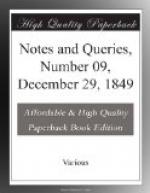But the centres and this inscription are the least difficulty. A second, frequently met with, is by far more puzzling. I could not give your readers any idea of it without a drawing: however it is found imperfectly depicted on the plates I have before mentioned in Nash’s Worcestershire, and the Gentleman’s Magazine, and I think I recollect also a very rude copy in a volume of Hearne’s Miscellaneous Works, which I examined in the Gottingen Library, but whether belonging to the work or a MS. addition I cannot now call to mind. The fanciful and flowery form of its letters gives great scope to the imagination in assigning them their particular position in the alphabet, and the difficulty of reading them is enhanced by the doubts of German archaeologists whether they are initials or component parts of a sentence. Herr Joseph v. Hammer Purgstall, however, in his version RECORD DE SCI GNSI, or in full Recordamini de sancta Gnosi, deduces thence his principal proof of Gnostic heresy amongst the calumniated Templars, in which I am sorry to say he has been too servilely followed in England: e.g. by Mr. Godfrey Higgins, in his posthumous Anaclypsis (p. 830 note), as well as by E.G. Addison, The Temple Church (p. 57), and by Mr. R.W. Billings more especially, who tacks to his account of this building an “Essay on the symbolical Evidences of the Temple Church, where the Templars are proved Gnostic Idolators, as alleged by Edward Clarkson, Esq.” Had the learnedly hypothetic Austrian seen the engravings of the Crypt at Canterbury Cathedral (Archaeologia, viii. p. 74.), and Ledwick’s remarks on it in conjunction with the carvings at Glendalloch (History of Ireland, p. 174.), or those of Grymbald’s Crypt at Oxford, he might have been expected to have attributed their monstrosities to his order, with as little hesitation and as thorough a contempt of chronology, or proved connection, as he has the curious and innocent sculptures of the church at Schoengrabern in Bohemia (vide Curiositaeten, vol. viii. p. 501.).
WILLIAM BELL, Phil. Dr.
* * * * *
MINOR NOTES.
Prince Modoc.—At p. 57., “ANGLO-CAMBRIAN” refers to the report of the Proceedings of the British Association at Swansea, in Aug. 1848, extracted from the Athenaeum newspaper. In the course of a discussion which took place on Prof. Elton’s address, it was observed (if I recollect rightly) by the learned Dr. Latham, that a vocabulary of the so-called Welsh-Indian dialect has been formed, and that it contains no trace of any Celtic root.
J.M.T.
December 10. 1849.
St. Barnabas.—About the time of the Reformation, it was strongly debated whether the festival days of St. Paul and St. Barnabas should be admitted into the calendar; and, in the 2d Book of K. Edward, the conversion of St. Paul is put down in black, and St. Barnabas is omitted altogether! No wonder, therefore, if, in Suffolk, liberties were taken with the name of St. Barnabas, and it was transferred to doggerel rhyme, to be repeated by children.




